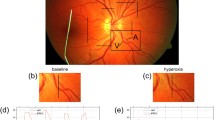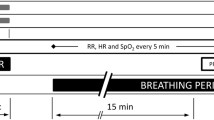Abstract
Studies on retinal oxygen and glucose consumption in cats and pigs are reviewed and recent experiments with the deoxyglucose method in monkeys are described. In all three species, the retina is supplied with nutrients by both the retinal and the choroidal blood vessels. Studies on regional blood flow and differences in arteriovenous concentration in cats have indicated that under conditions of general anesthesia and exposure to laboratory light, the oxygen supply from the choroid is about 5.6 µl/min and that from the retinal vessels, 1.3 µl/min. In pigs the corresponding figures were about 4 and 2.9 µl/min, respectively. Moderate reductions in perfusion pressure caused by increments in intraocular pressure or reductions in arterial blood pressure resulted in little change in oxygen tension in the inner retina, due to efficient autoregulation of retinal blood flow. Reduced choroidal blood flow was to a large extent compensated by increased differences in arteriovenous concentration. Studies using the deoxyglucose method in monkeys indicated that pentobarbital anesthesia and constant illumination tend to reduce the metabolism of the retina. In darkness, glucose consumption in the photoreceptors was higher than that recorded under conditions of constant illumination with white light. Flickering light at 4 Hz enhanced glucose consumption in the inner retina. At very high intraocular pressures glucose consumption in the retina was enhanced, probably as a result of partial ischemia, with a shift to more anaerobic glucose metabolism.
Similar content being viewed by others
References
Alder VA, Cringle SJ (1989) Intraretinal and preretinal PO2 response to acutely raised intraocular pressure in cats. Am J Physiol 256:H1627–1634
Alm A, Bill A (1970) Blood flow and oxygen extraction in the cat uvea at normal and high intraocular pressures. Acta Physiol Scand 80:19–28
Alm A, Bill A (1972) The oxygen supply to the retina: II. Effects of high intraocular pressure on uveal and retinal blood flow in cats. A study with labelled microspheres, including flow determinations in brain and some other tissues. Acta Physiol Scand 84:306–319
Alm A, Bill A (1972) The oxygen supply to the retina: I. Effects of changes in intraocular and arterial blood pressures and in arterial PO2 and PCO2 on the oxygen tension in the vitreous body of the cat. Acta Physiol Scand 84:261–274
Bill A (1962) Intraocular pressure and blood flow through the uvea. AMA Arch Ophthalmol 67:336–348
Geijer C, Bill A (1979) Effects of raised intraocular pressure on retinal, prelaminar and retrolaminar optic nerve blood flow in monkeys. Invest Ophthalmol 18:1030–1042
Hickam JB, Frayser R (1966) Studies on the retinal circulation in man. Observations on vessel diameter, arteriovenous oxygen difference, and mean circulation time. Circulation 33:302–316
Linsenmeier RA (1986) Effects of light and darkness on oxygen distribution and consumption in cat retina. J Gen Physiol 88:521–542
O’Rourke J, Benson C (1970) Oxygen uptake by canine uveal tissue: in vitro and in vivo methods compared. Invest Ophthalmol 9:1127–1129
Sokoloff L (1985) Basic principles in imaging of regional cerebral metabolic rates. In: Sokoloff L (ed) Brain imaging and brain function. Raven Press, New York, pp 1–47
Sokoloff L, Reivich M, Kennedy C, Des Rosiers MH, Patlak CS, Pettigrew KD, Sakurada O, Shinohara M (1977) The [14C]-deoxyglucose method for the measurement of local cerebral glucose utilization: theory, procedure, and normal values in the conscious and anesthetized albino rat. J Neurochem 28:897–916
Sperber GO, Bill A (1985) Blood flow and glucose consumption in the optic nerve, retina and brain; effects of high intraocular pressure. Exp Eye Res 41:639–653
Törnquist P, Alm A (1979) Retinal and choroidal contribution to retinal metabolism in vivo. A study in pigs. Acta Physiol Scand 106:315–357
Törnquist P, Alm A, Bill A (1979) Studies on ocular blood flow and retinal capillary permeability to sodium in pigs. Acta Physiol Scand 63:343–350
Ullberg S (1977) The technique of whole body autoradiography. Cryosectioning of large specimens. In: Science tools: whole-body autoradiography. LKB Instrument Journal, Bromma, Sweden, pp 1–29
Zuckerman R, Weiter JJ (1980) Oxygen transport in the bullfrog retina. Exp Eye Res 30:117–127
Author information
Authors and Affiliations
Rights and permissions
About this article
Cite this article
Bill, A., Sperber, G.O. Aspects of oxygen and glucose consumption in the retina: effects of high intraocular pressure and light. Graefe’s Arch Clin Exp Ophthalmol 228, 124–127 (1990). https://doi.org/10.1007/BF02764305
Received:
Accepted:
Issue Date:
DOI: https://doi.org/10.1007/BF02764305




